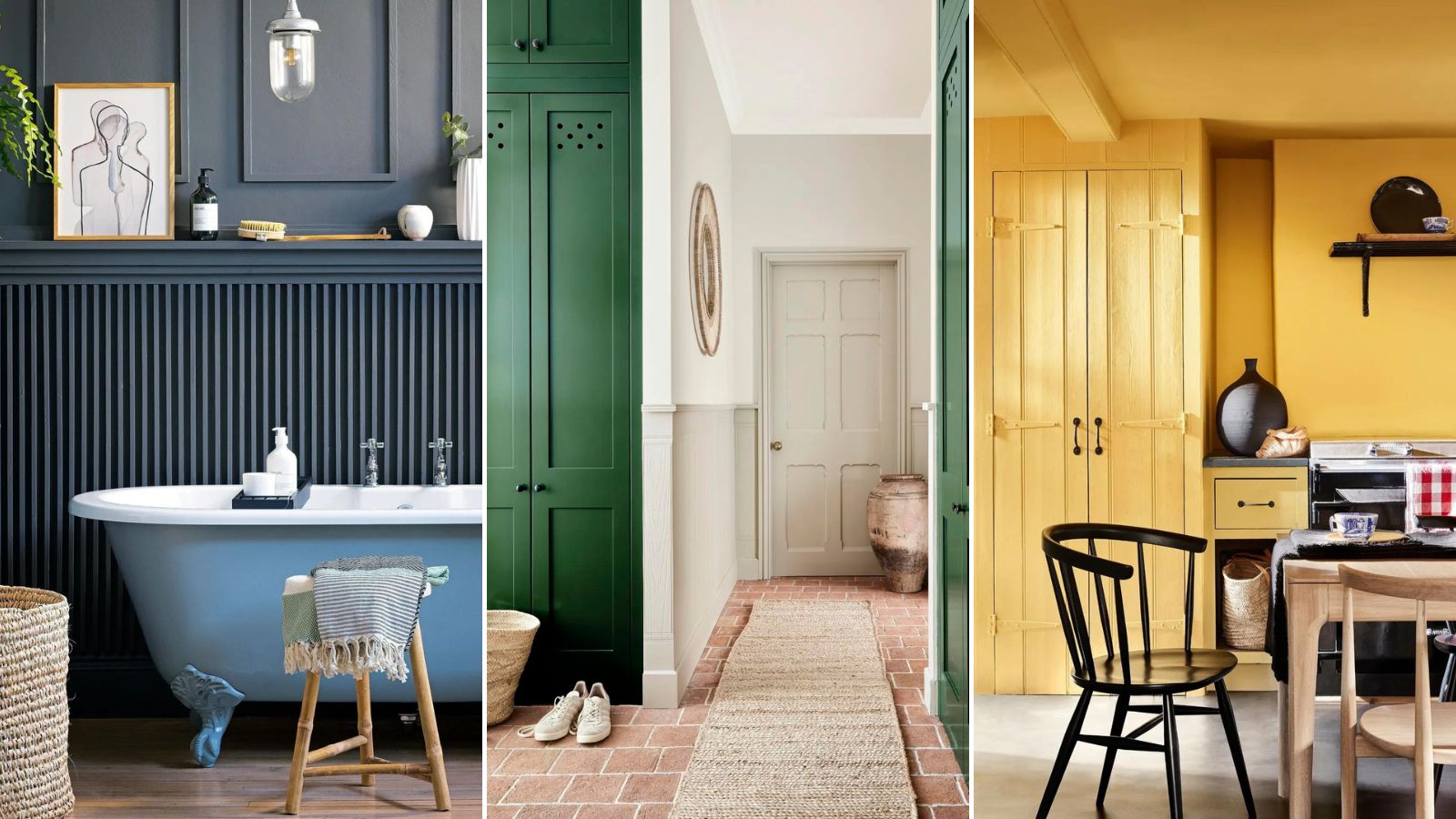How to paint a wall – master painting a wall like a pro
Donning your DIY cap and learn how to paint a wall like a pro? Our expert guide talks you through this simplest of renovation jobs, step-by-step

Gabriella Dyson

Painting a wall is one of the easiest and most affordable ways of updating any room. And you don't have to get professionals in to do an aesthetically pleasing job of it.
But, before you start to paint a room, it is a good idea to learn a few tips from top experts on how to paint a wall like a pro before you start.
After all, you're going to be looking at those walls for a long while to come. We've consulted experts from the likes of Benjamin Moore, Lick and Dulux for their insight into how to paint a wall to perfection – so that you can bring your paint ideas to life yourself.
How to paint a wall: An essential guide
Here, we tackle the basics of painting a wall – using the expert tips we've added will ensure you get a professional finish.
1. Measure your room and determine how much paint you need
If you've been browsing living room paint ideas and are wondering whether you could work the transformation yourself – and how much it costs to paint a room – the first thing to get to grips with is paint quantities.
'There is no "average room", so it’s important to roughly calcuate how much paint you will need to avoid buying too much,' says Helen Shaw, Director at Benjamin Moore. 'As a guide, it’s key to bear in mind that most paints will cover about 10-12sq m per liter. '
She continues: 'Firstly, we recommend starting by measuring or estimating the room's length. A loose and easy guide for this is stepping it out – one step for an adult is about 1m, so start by standing against one wall and pacing out to the opposite wall. You can then do the same to estimate the width. Then add two times the length and two times the width together to get the perimeter.
Design expertise in your inbox – from inspiring decorating ideas and beautiful celebrity homes to practical gardening advice and shopping round-ups.
'Most rooms have a standard 2.5m high ceiling, so if you simply multiply the perimeter by 2.5, you will have the total in meters squared. Although we would recommend that if you have particularly tall ceilings, it’s best to measure this rather than use the 2.5m estimate. If you have large windows or many doors or built-in cabinets, you can deduct this from the total to avoid buying too much. Finally, double the overall meter square total to account for doing two coats.'
2. Choose your color and get the right finish
Whether you're looking for organic, neutral or bold, statement living room color schemes, picking up a selection of sample pots is always a good idea to see how the hue reacts to the light in your space.
And don't forget the paint finish. 'The right paint finish for different surfaces and specific results is the key to a perfect result,' say the experts at Dulux. 'For example, mid-sheen and gloss finishes reflect light, while kitchen and bathrooms require moisture and stain-resistant qualities.'
3. Buy the right tools
When painting a wall, there's nothing worse than realizing too late that you haven't got all the tools you'll need to do the job properly. You will need a pot of paint, a paintbrush and paint roller, primer, soap and water for cleaning, a painting tray, a dust sheet, painter's masking tape, and, if you have high ceilings, a roller extension pole is a good idea.
Benjamin Moore's Helen Shaw says: 'When it comes to the must-have tools, a firm favorite amongst consumers is to use a roller for painting walls and a 2in brush for cutting in around the edges. To ensure a smooth finish, a microfiber roller sleeve is best.'
4. Paint in natural light
For best results, always paint in natural, not artificial or low, light.
A Dulux expert advises: 'Whether you're rushing to get the job done just as the sun goes down or it’s dark and stormy outside, it’s always better to wait for bright, natural light to paint your rooms. Painting in dim or harsh artificial lighting can easily result in patches and imperfections that only show up in glaring natural light.'
5. Clear the area
Now you've got the right amount of paint in the correct finish and color of choice, you're ready to take the next step in painting a wall.
'Start by clearing your working area to give yourself ample painting space,' says Lick’s Interior Design and Colour Psychologist, Natasha Bradley. 'Put away your favorite furniture items and anything you don’t want to get splatters or splodges on.
'Put a protective dust sheet down to save your flooring and any furniture that’s too heavy to move. Newspapers and bedsheets won’t be sufficient here, but either a canvas or a plastic drop sheet should work equally well.'
Helen Shaw, UK Director of Benjamin Moore adds: 'Before you jump in with your paint brush, make sure the space around you is prepped and cleared – you don’t want to be spilling paint over your new sofa! If there’s not enough space to clear the room entirely, push everything to the centre of the room and cover, don’t forget to also cover the flooring.'
6. Prep your walls
'Once everything is cleared and covered, you can then make a start on preparing the walls for painting,' says Helen Shaw. 'A key factor in ensuring you have a smooth finish is having a clean surface to paint on, dust, cobwebs or grime can stop your paint adhering and having the perfect finish. Most walls can be washed with a soft sponge and warm water, but if you’re painting in the kitchen then you’ll need something to help cut through the grease before rinsing with warm water.'
Speaking to H&G, a Dulux expert says: 'It’s very tempting to skip this crucial first step, whether it’s to save time or because you think your walls look fine to paint over. But, it’s often hard to see dirt, dust, scratches and cracks, until they rear their ugly heads through your new paint. Before you do anything, give your walls a good clean with warm, soapy water, fix any cracks or holes with filler and wait until the surface is totally dry before painting.'
Be ultra-vigilant about this step, says Lick's Natasha Bradley. 'Examine your wall for any flakey areas or little bumps. Use filler and sealant to fill up any cracks or holes or a scraper to even bumps and flaking paint. Don’t skip this step if you want to achieve a smooth and professional finish.
'Next, get your painting surface ready. Clean your walls thoroughly but gently using a soap and water mixture. Wipe clean and leave to dry.'
7. Apply your painter's tape
Once the surfaces are dry, use painter’s masking tape or good, old-fashioned masking tape to cover any sockets, switches and skirting boards in the area.
Helen Shaw says: 'You’ll need a roll or two of painter’s tape to protect any moldings or switches from any drips and ensure a neat finish. Ensure you apply the tape carefully to get a good seal to avoid paint getting underneath and running.'
8. Time to prime
Using a primer will ensure a more professional finish and help you get the most from your paint color. 'Apply a smooth and even base coat of primer using a roller,' says Lick's Natasha Bradley. 'Work into smaller crevices using the tip of your paintbrush. Leave to dry for a few hours before starting to paint.'
She adds: 'Avoid the temptation to skip the priming stage if you want a vivid and consistent finish, especially if you’re painting over a darker color.'
9. Stir and decant your paint
After opening a paint can, stir the paint thoroughly for an even texture, before pouring some into your painting tray.
A Dulux expert says: 'As colors can vary slightly from can to can, it pays to decant paint into a smaller container or tray to mix it before you start painting. In terms of how to decorate while making the least amount of mess, this tip might just save your sanity. Imagine accidentally knocking over a 10 liter can of paint?'
Kathryn Lloyd, of Crown Studio, offers her top tip: 'Pour the paint into the roller tray and, for ease, you can use some aluminium foil within the tray to save you cleaning it out afterwards. Once you’ve finished with the paint you need, pour the residual paint back into the can and you can dispose of the foil without using tons of water.'
10. Cut in the edges
Before you start painting the walls, cut in the edges with a one or two-inch brush. This means first painting the areas that are too tight for rollers, like the ceiling line, corners and trim.
Benjamin Moore's Helen Shaw advises: 'To cut in with ease, a low-tack tape around the ceiling edges or skirting will help to get a sharp line and a clean finish. Gently remove the tape when the paint is still wet to ensure there is no bleed through or peeling.'
Kathryn Lloyd's top tips on cutting in while painting a wall? 'Apply some paint onto the brush, providing any excess has been removed to guarantee you have control when using the brush and keep the paint looking neat along the edges.
'With your paint brush in hand, start a little bit away from the edge of the wall, so that you have the right amount left on the brush to create a very sharp edge so that it’s nice and neat. Repeat this for the top, bottom and sides of the wall.'
11. Paint your wall from top to bottom
From preparation to painting, work from the top of your room down, for best results. Start with the ceiling and the architrave. Then, paint your walls from the top down with your roller. Finish the job with woodwork and skirting.
12. Use this painting technique for best coverage
'If you’re flinging your roller around, you might not achieve the best coverage,' say the experts at Dulux. 'Instead, apply your paint in a W shape on the wall. Go over the W with an M shape to fill in the gaps, then reload your roller and move onto the next section in the same way.'
Lick's Natasha Bradley agrees this is a good technique for painting a wall, saying: 'Dip your roller into the paint tray and start to paint your wall in W or M motions for even distribution.'
13. Apply another coat of paint
Leave the first coat to dry for a couple of hours before you apply another coat.
'Most walls shouldn’t require more than two coats of paint,' says Natasha Bradley. 'Remove the painter's tape from the wall whilst the second coat is still drying.'
14. Don't forget ventilation
To make the experience more pleasant for you, open the windows and let some air in.
Natasha Bradley advises this will also quicken up the wait: 'Keep your work area well-ventilated to minimize drying time.'
15. Clean up ready for the big reveal
Leave to dry for at least 24 hours and remove your dust sheets to reveal your brand new wall. Keep your brushes in good condition by cleaning them before you put them away. If you've used a water-based paint, a clean with soap and water will suffice.
Now it's time to step back, admire your own handiwork, and give yourself a well-deserved pat on the back.
Remember to keep the colors you’ve used so you can touch up paint on walls as necessary and make sure to dispose of paint safely when you do finally come to changing to a different wall color.

Ruth Doherty is an experienced digital writer and editor specializing in interiors, travel and lifestyle. With 20 years of writing for national sites under her belt, she’s worked for the likes of Livingetc.com, Standard, Ideal Home, Stylist and Marie Claire as well as Homes & Gardens.
- Gabriella DysonContributor